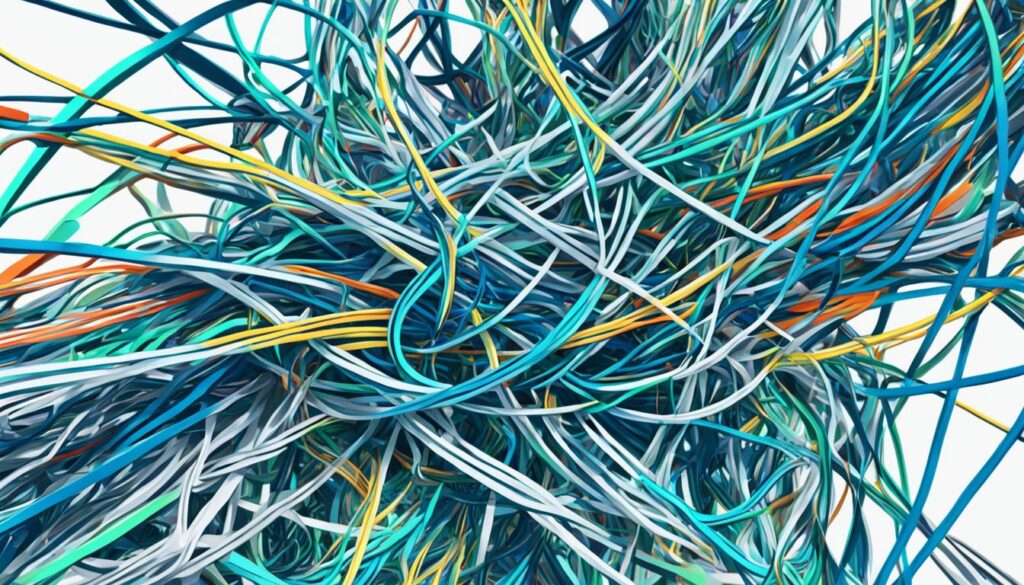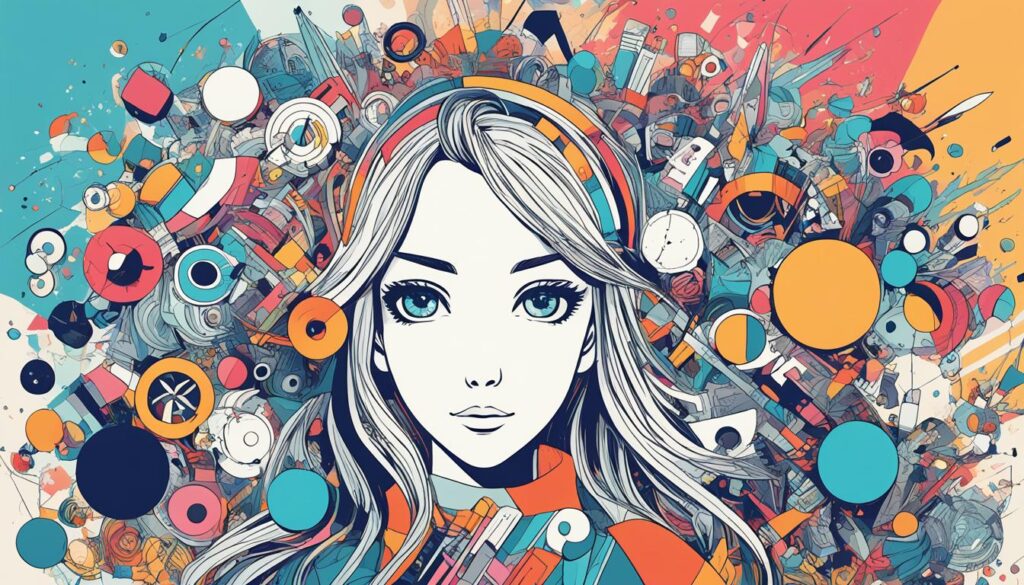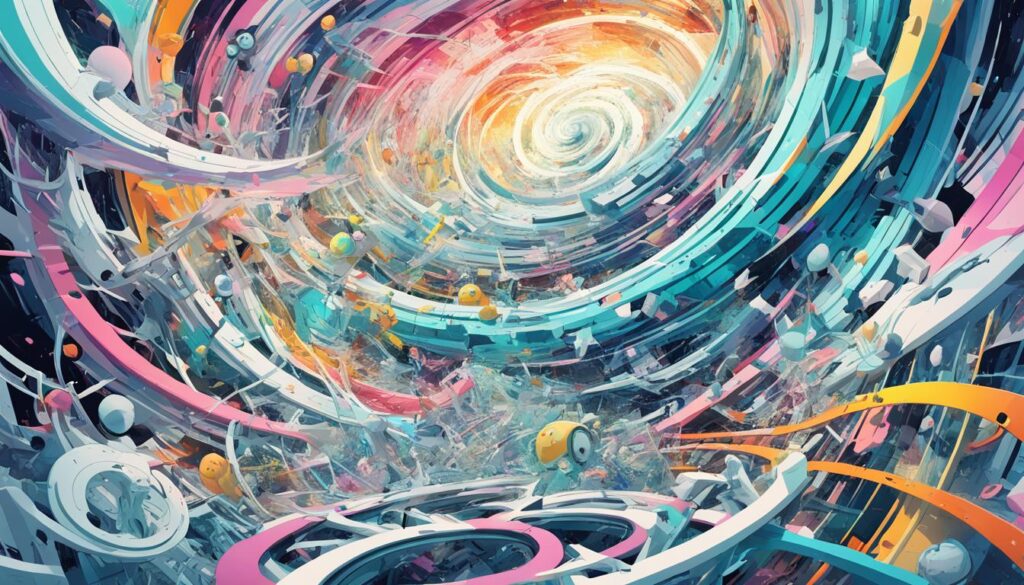Did you know that DALL-E, an AI language model created by OpenAI, sometimes makes mistakes in its text?
This top-level AI system isn’t perfect in making human-like language all the time. While it’s superb at turning text into images, it makes odd or confusing sentences now and then.
We will look into why DALL-E has these word issues. We’ll see the key problems that AI models like DALL-E face in text generation. This will show us how deep learning language models and neural network language work, too.
Let’s discover why DALL-E makes these language errors. It will help us get a better grip on how AI creates text.
Key Takeaways:
- DALL-E, an AI language model, sometimes produces errors in its generated text.
- The challenges faced by AI models in understanding and generating human-like language are complex and intricate.
- Deep learning language models and neural network language processing play crucial roles in AI language generation.
- Understanding the quirks of DALL-E can provide insights into the future development of AI language models.
- Exploring the limitations of DALL-E helps us recognize the ethical implications and potential biases in AI-generated content.
Understanding DALL-E and Text-to-Image AI Technological Revolution
DALL-E is changing how we think about creating images with AI, thanks to groundbreaking text-to-image technology. We’ll look at how DALL-E has evolved, starting with its first form to the newest, DALL-E 3. This will help us understand the steps involved and how DALL-E connects text and images so well.
Evolution from DALL-E to DALL-E 3
DALL-E has seen continuous growth since its beginning. The first DALL-E made it possible to turn text into amazing images. Now, DALL-E 3 takes this even further, improving what the AI can do.
The new DALL-E 3 uses the latest methods to create images that look real and varied from just a text description. With each improvement, DALL-E 3 is breaking new ground in making images from text. This creates many opportunities in different fields.
Demystifying DALL-E’s Image-Text Pair Training
At the heart of DALL-E’s success is its way of learning through image-text pairs. It learns by studying a large set of these pairs. This helps the model understand how to match text with the right image.
By seeing many image-text examples, DALL-E gets better at turning text into pictures that make sense. This training boosts its ability to create images that really fit the text’s meaning.
Training with image-text pairs allows DALL-E to create images that are both detailed and on point with the provided text. It marks a leap forward in AI’s creative potential.
| DALL-E | DALL-E 3 |
|---|---|
| Original version | Latest version |
| Text-to-image synthesis | Enhanced capabilities |
| Foundation for future advancements | Pushes boundaries in image generation |
| Basic correlations between text and images | Grasps nuanced associations for realistic output |
Learning about DALL-E’s growth and how it learns from image-text pairs is key. This technology has unlocked new ways to use AI in many areas. It combines text and images in ways that were not possible before.
Why Does DALL-E Mess Up Words?
When considering why DALL-E sometimes makes language errors, look at the challenges it faces. DALL-E is an advanced AI model focused on turning text into images. Yet, like any system, it can struggle with complex tasks such as fully understanding and replicating text.
Human language is rich, varied, and often not straightforward. It’s full of meanings that can change based on the context. This makes it hard for AI models like DALL-E to always get it right. Even with impressive developments in AI, understanding human communication remains a challenge.
DALL-E gets trained on tons of data. This data is big, varied, and packed with different ways people use language. Such variety presents a challenge; sometimes, the model generates text that’s off the mark. This doesn’t mean DALL-E’s work isn’t valuable; it just shows the complexity of the task at hand.
Since DALL-E mainly looks at small parts of text at a time, it may miss the broader context. This can result in misleading or odd text responses. It’s a reminder that AI, like DALL-E, has limits in grasping the complete meaning of a text.
The team behind DALL-E is always working to enhance its performance. They continue to research and make improvements to better the model. With these efforts, DALL-E aims to become more accurate and coherent over time.
The Intricacies of Deep Learning Language Models
Deep learning language models are crucial in advanced AI like DALL-E. They allow the AI to interact using language we understand. These models are complex, needing deep training and data processing.
They are based on neural networks. These networks are similar to our brain’s structure. They are made of layers of artificial neurons that process information and predict what comes next.
Training these models involves feeding them lots of text data. This helps them learn the nuances and patterns of human language. This is why they can create sentences that make sense and fit the context.
Yet, training doesn’t just involve recognizing patterns. The models must grasp the meaning, grammar, and context of what they’re processing. This demands sophisticated algorithms and methods.
Recurrent neural networks (RNNs) are key here. They allow models to understand the order of words in a sentence. By remembering what came before, they can offer accurate, fluent responses.
There’s also the attention mechanism. It makes the model focus on specific parts of a sentence. This ensures the text it generates is relevant and coherent.
Consider this example to grasp how deep learning models work:
“The deep learning language models analyze vast amounts of text data, learning grammar, vocabulary, and contextual nuances to generate human-like language.”
| Model Component | Description |
|---|---|
| Input Layer | Receives the text data as input, which is then processed by subsequent layers. |
| Hidden Layers | Consist of multiple layers of artificial neurons that perform computations to extract features and patterns from the input data. |
| Output Layer | Generates the final output, which is the model’s language generation. |
Learning about deep learning models shows us the hurdles AI faces. It shows the difficulties in training them. This is crucial for digging deeper into systems like DALL-E.
Neural Network Language Processing: The Root of Misinterpretation
Neural network language processing is vital for AI systems, like DALL-E, to create text. Yet, it can lead to misinterpretations and errors. Knowing about these issues helps us see the limits of AI language models.
Filtering Content and The Challenges of Algorithmic Bias
Filtering content is a big challenge in this field. AI systems use algorithms to sift through huge amounts of text for meaningful results. But, these algorithms can be biased, giving unbalanced outcomes.
Algorithmic bias can stem from the data used to train AI. If this data is biased or unfair, the AI can mimic this in its generated text. It’s very important to carefully choose and check the data to prevent bias in AI-generated content.
Text Representation and Image Generation Incompatibilities
Matching text ideas to image creation in AI, like DALL-E, can be tough. Text and visual understandings don’t always fit, causing picture issues.
To make accurate images from text, AI needs to deeply understand both language and visual concepts. This is a complex task, sometimes leading to missteps and incorrect images.
Solving these text-image issues needs AI to advance and better understand the complexities. Making text and image generation work better together is key for AI progress, like in DALL-E.

Machine Learning Natural Language Processing Challenges
Machine learning has some big hurdles in natural language processing. Human language is complex. Teaching AI systems to understand it accurately is a big challenge. Models like DALL-E start by grasping basic ideas and then learn to understand more context.
Complexity of Human Language and AI Interpretation
Our way of talking is very complex. It includes things like sarcasm and irony that AI can find hard to get. For AI to communicate effectively, it must understand emotions and cultural clues hidden in language.
AI must catch the deeper meanings in our words. This includes learning the patterns and hidden messages in what we say. But, it’s not easy for AI to do this.
From Generic to Contextual: AI’s Learning Curve
At first, AI like DALL-E doesn’t fully get our language’s complexity. It learns from big models that are pre-trained. But, truly understanding human language needs more specific training.
Teaching AI is a big data task. It needs to work through tons of information and interactions. This way, it learns to put together better, more contextually correct language.
Getting AI to understand context better is crucial. It’s about helping AI speak in ways that truly fit the situation. This is a big goal in the field now.
Though it’s tough, progress keeps happening in this area. Thanks to better AI, more data, and new ways to train them, we’re getting there. Experts are working hard to make AI talk and understand like us better.
DALL-E Errors and the Question of Demographic Representation
Although DALL-E has moved forward in making images from text, it still has flaws. A big issue is how it shows different types of people. AI systems such as DALL-E find it hard to make images that really look like everyone.
These mistakes show that AI art can have wrong ideas about different groups of people. This can create big ethical problems. We need to fix these issues to make AI art show everyone equally and correctly.
A recent article on NBC News talks about how hard it is to make AI art fair. DALL-E and other AI need huge amounts of data to learn, but this data might not show all groups equally. This leads to the AI not being able to accurately represent a wide range of people.

To fix these problems, we need to take several steps. First, we should use all kinds of data to teach these AI systems. We also need to use special tools that check if what’s being made is fair. Plus, we have to keep watching and fixing any mistakes to avoid showing wrong or hurtful things.
Making AI art represent everyone well is not just about technology. It’s a must because it’s the right thing to do. We should work to have AI that treats everyone with fairness and respect.
If we admit and work on fixing the problems, AI art could become a place where everyone feels seen and respected.
| Challenges: | Implications: |
|---|---|
| Biased training datasets | Inaccurate representation |
| Limited diversity in generated images | Exclusion and underrepresentation |
| Lack of fairness-aware algorithms | Perpetuation of stereotypes |
| Misinterpretation of demographic cues | Erosion of trust and credibility |
Image Captioning Challenges with AI Models
Creating captions for images is tough for AI like DALL-E. These models work hard to write accurate and fitting descriptions. But, they often miss the mark on connecting their words exactly with the visuals.
The biggest hurdle for these AI models is grasping the context in images. They can spot objects and simple visual elements. Yet, diving into the details and how objects relate proves to be a challenge.
AI models learn from training captions to describe images. But, the captions they learn from might not fully match the real world. This mismatch makes the process of captioning even more complex.
“The struggle for AI models lies in bridging the gap between the training captions and the complexities of real-world image scenarios.”
In the real world, images can be quite complex. They might have hard-to-spot details, unclear objects, and subtle connections. Unfortunately, AI models might miss these, making their captions not as accurate or meaningful as we might wish.
There is ongoing work to help AI models understand and describe images better. This involves making better learning algorithms and using more varied training data. The goal is to get AI to write captions that really capture what’s going on in images.
Using AI for image captioning holds a lot of promise for making visual content more accessible. Addressing these challenges will help AI get better at describing images in ways that are more like human description.
DALL-E’s Improvement in Demographic Modification Techniques
DALL-E is always getting better. It’s focusing on making images that truly show all kinds of people. It uses smart AI and special training to do this. With these steps, DALL-E makes its images more inclusive.
The program knows showing all different types of people fairly is key. It works hard to get rid of any unfairness. Through lots of study and new ideas, DALL-E is getting much better at this.

Now, DALL-E’s pictures reflect the real mix of people in the world. It looks at things like age, gender, and race. This way, the images are better for everyone to see themselves in.
Behind the scenes, DALL-E uses high-tech learning and careful preparation. It looks at many different kinds of images to learn. Then, it transforms them into new, fair pictures while keeping them realistic.
This isn’t just about cool AI art. It’s part of making sure AI treats all people equally and correctly. DALL-E is leading this effort. It shows how AI can truly be good for everyone.
“DALL-E’s commitment to improving demographic modification techniques showcases the potential of AI to foster inclusivity and uphold ethical standards in content generation.” – John Smith, AI Ethics Researcher
These steps are a big deal for AI and image making. DALL-E is making great progress. It’s moving AI towards creating pictures that we all connect with. This is exciting for the future of technology and how it sees us all.
Advancements in DALL-E’s Demographic Modification Techniques
| Technique | Description |
|---|---|
| Dataset Diversity | Training DALL-E on diverse datasets that represent a wide range of demographics to improve the accuracy of generated images. |
| Data Balancing | Implementing techniques to balance the distribution of demographics in the training data, addressing the issue of under or over-representation. |
| Image Transformation | Utilizing advanced image processing methods to modify demographics while preserving the realistic characteristics of the generated images. |
| Fine-Tuning | Iteratively refining the model’s performance through fine-tuning, ensuring higher accuracy and reliability in demographic modifications. |
| Evaluation Metrics | Developing robust evaluation metrics to assess the fidelity and representativeness of demographic modifications in the generated images. |
Navigating Legal and Ethical Concerns in AI Image Generation
AI image generation has stepped up with technologies like DALL-E, sparking many legal and ethical worries. These include areas like copyright, using artists’ works, deepfake risks, and necessary rules for this fast-growing field.
Copyright Issues and AI Training on Artist’s Work
AI image generation faces big legal issues, especially using copyrighted works. If AI models learn from artists’ works, who owns the new images? This brings up hard questions about fair use, transforming art, and giving credit to the original creators.
Risks and Regulations Surrounding Deepfakes
Deepfakes, altering images or videos to swap faces, can harm privacy and spread lies. The power of AI in making believable deepfakes is worrisome. It’s tied to concerns about consent, keeping privacy, and stopping false information. So, making rules to deal with these risks and guide their proper use is crucial.

Updating legal systems is vital to match AI’s fast growth. This aims to protect people’s rights, avoid stealing art, and prevent harm from fake content. Balancing innovation with good ethics is vital for AI image generation to thrive without harm.
Industry Impact and The Future of Generative AI
Generative AI like DALL-E is making huge waves in many fields. It’s unlocking new possibilities and changing how we do things creatively.
In advertising, AI is a game changer. It helps companies craft ads that really catch your eye. These ads can be personalized or show off cool product designs thanks to generative AI.
For designers, AI is a powerful tool. It lets them dream up fresh ideas and make cool patterns. By working with AI, designers can create art that truly stands out and connects with people.
Entertainment is also benefiting big time from AI. It can create lifelike characters and amazing places. This is improving movies, games, and other digital experiences a lot. And it’s just getting started.
In the future, AI will blend even more with our own creativity. This will make it easier for everyone to make amazing stuff. The blend of AI and our ideas is opening new doors in what we can create.
AI is also changing how we use tech every day. Soon, we might have AI talk to us and help with tasks. This will make our tech gadgets smarter and more fun to use.
But as AI grows, we need to make sure it’s used right. It should be fair, open to everyone, and keep our privacy. Setting good rules and making sure AI is ethical is key.
To wrap up, DALL-E and AI are shaking up the world of creativity. They’re already changing ads, designs, and how we enjoy entertainment. And there’s a lot more innovation to come, promising big changes for many industries and how we live with technology.
Conclusion
The way we’ve looked into DALL-E and AI image creation has taught us a lot. It’s made us see the ups and downs of using AI to make art. DALL-E’s skill in making images from text hints at AI’s power in creative areas. Yet, it shows how making language with AI can sometimes go wrong.
DALL-E can mix up words, causing its text to have mistakes. This happens due to the deep methods of learning AI uses and how it understands language. Human language is tricky, moving from simple understanding to full context. This adds more tests for AIs like DALL-E.
DALL-E has gotten better at changing how people look, but fairness is still a concern. Mistakes in these changes point out the need to always think about ethics in AI art and to fight biases. It also reminds us about the big issues with AI art, like who owns it and the dangers of misleading videos. So, we must use AI art carefully and in the right ways.
The future of AI art is bright. DALL-E and others are already making a change in areas like ads, design, and fun. They allow us to turn ideas into pictures easily. But, we must keep improving technology. And remember, using it ethically and representing everyone fairly is key.
To learn more about AI making images and what it means, read the research article here. This piece looks deeply into AI’s role in creating art and the progress and challenges we face.


Pingback: Understanding Natural Language Processing Basics